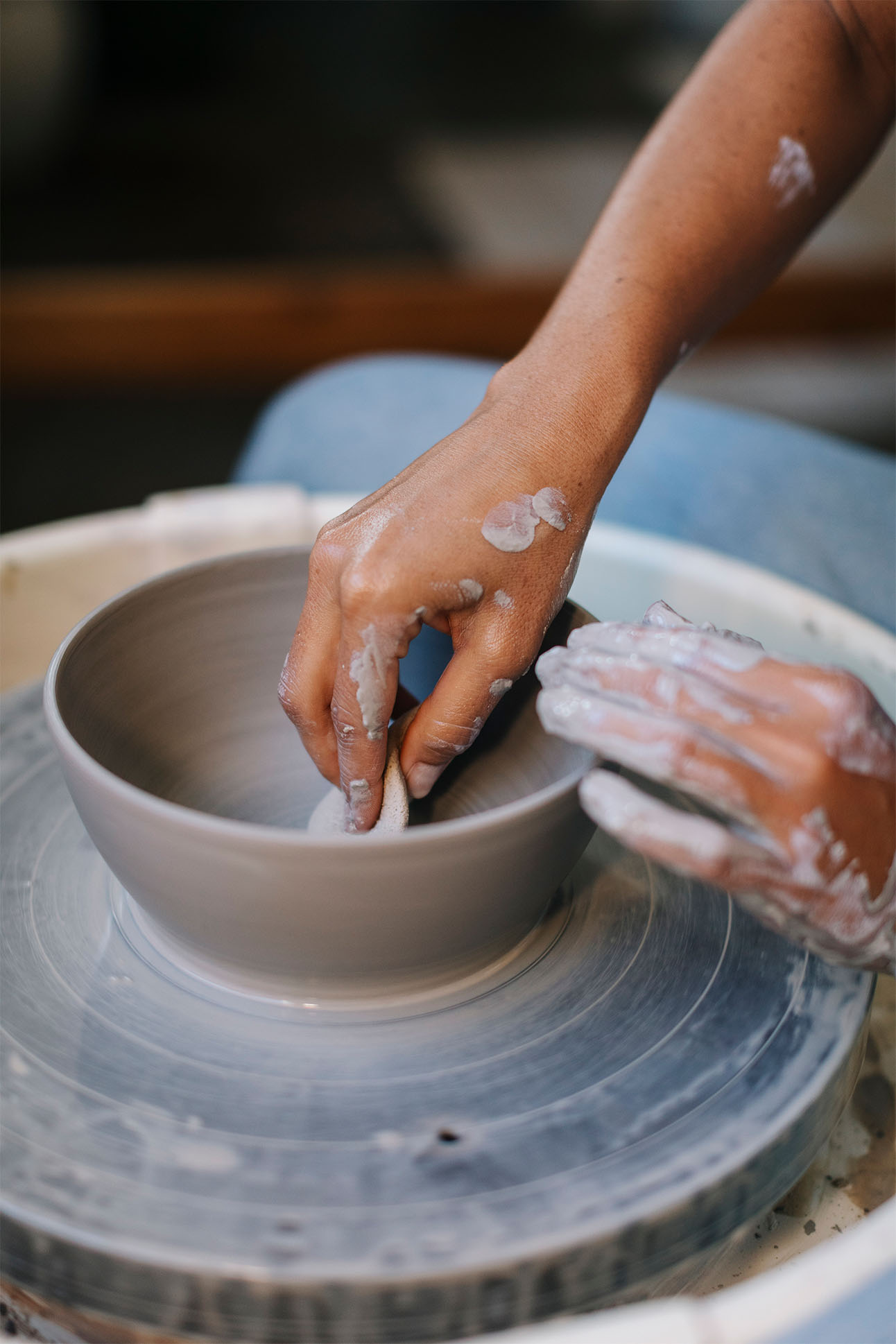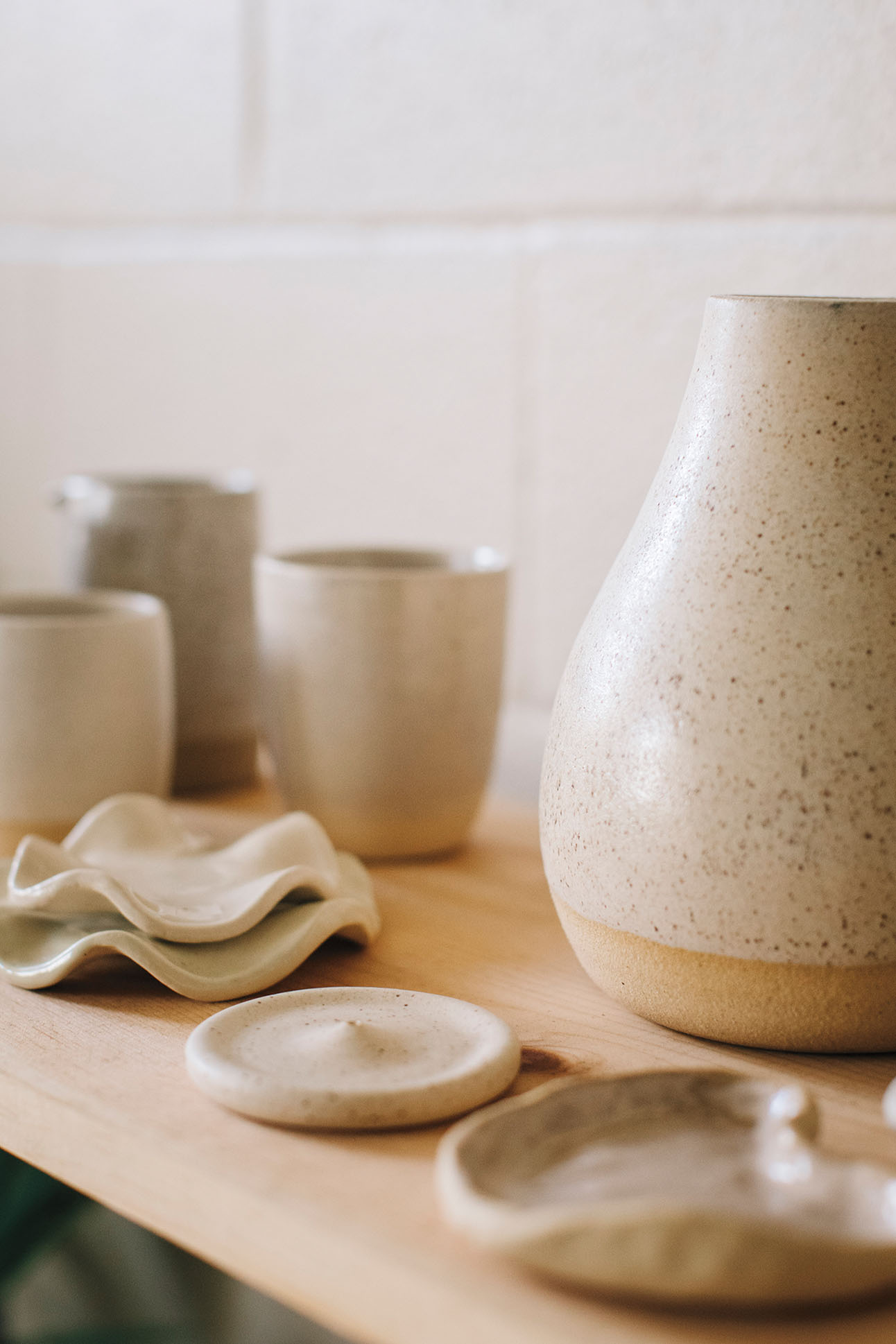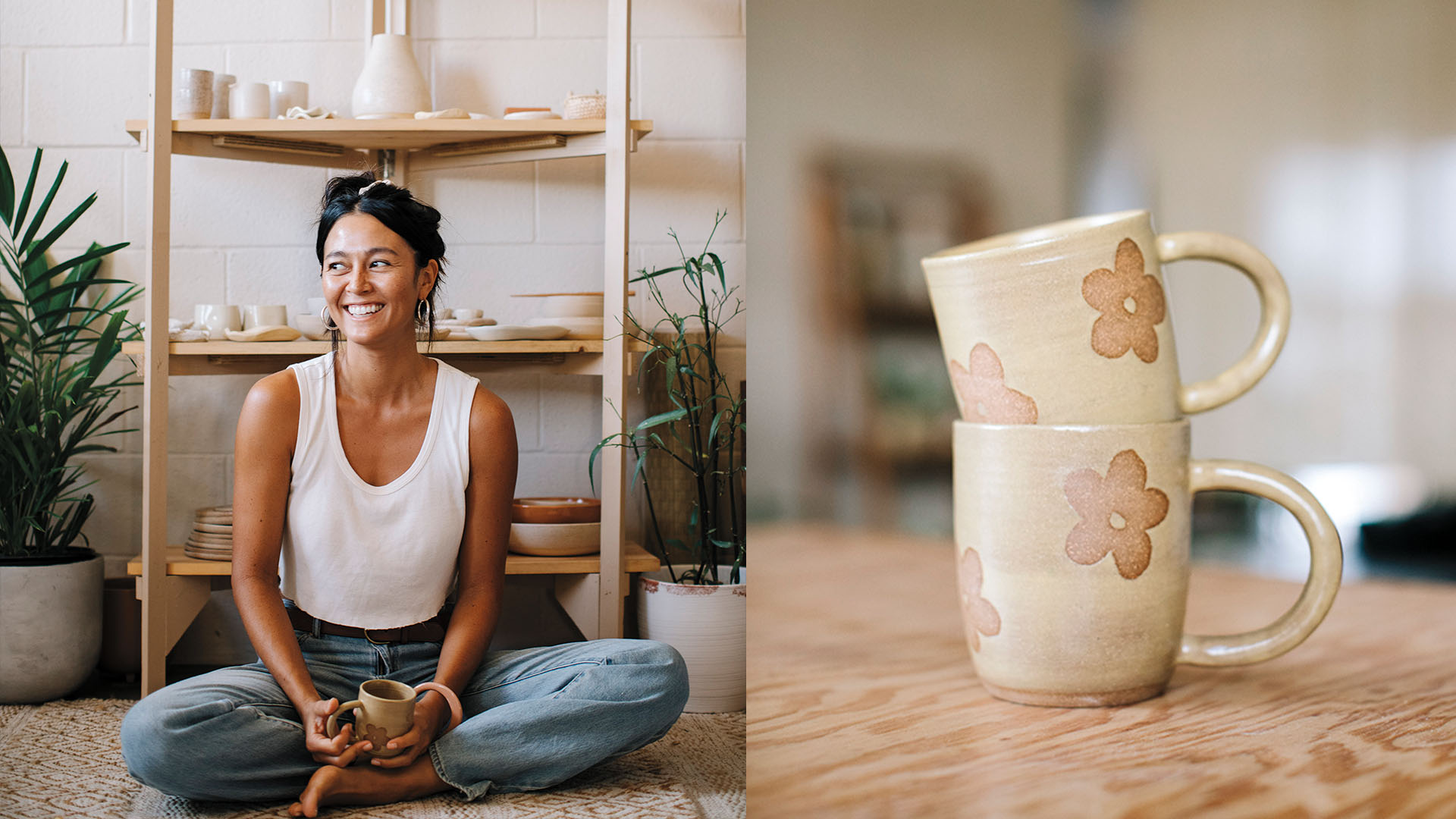Inspired by Japanese and Scandinavian design, the Honolulu ceramicist Tamiko Claire creates small-batch home goods with clean lines and earthy roots.
Images by Viola Gaskell
On a Saturday morning in October, Tamiko Claire is throwing pots in her Kaimukī studio. The weekend light filters through the slatted windows, illuminating a slate-colored bowl as it takes shape on her potter’s wheel. With each slight press of her fingertips, the clay grows taller and wider, expanding under the ceramicist’s touch. Once completed, the vessel will fit in nicely with the inventory that surrounds her—freeform vases, small platters, earth-tone cups inlaid with curvy hand-painted flowers—reflecting a blend of influences from different chapters of her life in Honolulu, Japan, and New York City.
“I’m always thinking about timing,” Claire, 34, says of the demands of ceramics, an art form that requires daily attention. One day she throws pots, and the next, once they’ve dried to a leathery hardness, she trims them, adds mug handles, or embellishes their surfaces with designs. Next comes bisque firing, a low-temperature blaze that desiccates the clay and solidifies its final form. Afterward, she either applies a glaze or leaves them unglazed for a more raw, natural look. Finally the pots are vitrified with a second firing, spending a day in a kiln hotter than 2,000 degrees. Nearly 20 years into her ceramics practice, Claire describes the style of the finished pieces that eventually emerge as “clean lines with earthy roots.”
Claire, who grew up in Nu‘uanu, O‘ahu, was first introduced to ceramics as a kid through handbuilding, an ancient pottery-making technique using only one’s hands and simple tools, then again as a high schooler at ‘Iolani where she learned to throw on a wheel. At 18 years old, she was offered a modeling job in Japan which took her to Tokyo for the next six years, and during that time, pottery became even more meaningful as an antidote to an occasionally dispiriting fashion industry. On trips to Kyoto to see her grandmother, Claire further developed her interest in the craft with visits to Bizen, a coastal city renowned for its rustic unglazed ceramics, and Shigaraki, a country town famous for its impressive noborigama, huge multi-tiered kilns situated on a slope allowing ash to rise and produce an array of natural glazing effects.

Following her full-time modeling career in Japan, Claire needed a reset before settling back into Hawai‘i, so in 2017 she moved to New York City where she joined a ceramics studio, Choplet, that offered 24-hour access. “I would go in early in the morning and just have it to myself, and really just play,” she says.
While she admired the glassy multi-hued ceramics she was exposed to early on in Honolulu, she felt there was room for simplicity and natural colors. Hawai‘i’s du jour color palette tends towards blues and browns that broke and pooled on pots, she observed, creating uneven, abstract color variations. Claire countermeasures this with a preference for opaque pastels and light earth tones in a style more decidedly Rothko than de Kooning. “I wanted to tie in Japanese aesthetics,” she says, “but also a bit of the Scandinavian style that I was exposed to in New York, while using colors of and textures inspired by Hawaiʻi.” The sandy-hued serveware she’s been making lately embodies this style: each plate, bowl, and cup have slight variations with a small pop of pastel or a bit of natural speckling in the clay, but they go together seamlessly as a set.
I like to incorporate, or be influenced by, things that remind me of love. That’s what I really hope to channel into what I’m making.



In New York City, she got a job at NeueHouse, a creative coworking space where she was exposed to the maker’s DIY mentality. “All of these people had their own businesses out of this shared work space,” she says. “It was inspiring.” When she moved back to Oʻahu two years later, she decided to put herself out there as a ceramicist. She began slowly, first by launching a website of her wares, then creating an Instagram account dedicated to her work. After making her public debut at Sunshine People Market, a seasonal fair of independent sellers in Kakaʻako, Claire sold at boutiques like At Dawn and Milo, before supplying Niu Valley’s Surf Camp with ceramic tableware. Just before Covid-19 reached the U.S., the apparel brand Madewell invited her to sell her products through their new online marketplace. With everyone stuck at home, and suddenly enamored with home goods, demand struck. “It was boot camp for producing higher quantities of one specific style,” Claire says. “It gave me a taste of what production pottery looks like.”
Wheel-throwing, however, is not a process that lends itself to pressure. With production-scale pottery, Claire says she gets to a point of muscle memory and she puts on some jazz house or an old Bob Marley album and just flows. When she throws, she is conscientious of her mood, and the music is intentional. “I like to incorporate, or be influenced by, things that remind me of love,” Claire says. “That’s what I really hope to channel into what I’m making.”

Recently, Claire moved from her home studio in Pālolo Valley to a commercial space in Kaimukī that smells of ‘olena and white ginger flowers (she shares the unit with Indigenous Soaps, another woman-owned business). She’s also been collaborating with chef Yuda Abitbol, who teaches foraging under the social media moniker @followsthewai; Abitbol gathered so-called “wild clay” in Mānoa and Pālolo for Claire to craft a set of custom plates for his private dinners. Since, Claire is still experimenting with the clay, wedging different amounts of material in with her regular stoneware and painting them with slip, a mixture of water and the wild clay, to see how it reacts to the firing process.
Despite the need to fill orders as her small business grows, Claire wants her process to stay “unforced,” as she puts it. If she’s having an off day on the wheel, she’ll hand-build or find something else to do. Because to center a lump of clay on the wheel, one also has to center oneself. “You have to be present,” she says. “We have so many things to think about all the time, it’s hard to allow ourselves to stop. Doing something tactile is really helpful for me to quiet my mind.”

